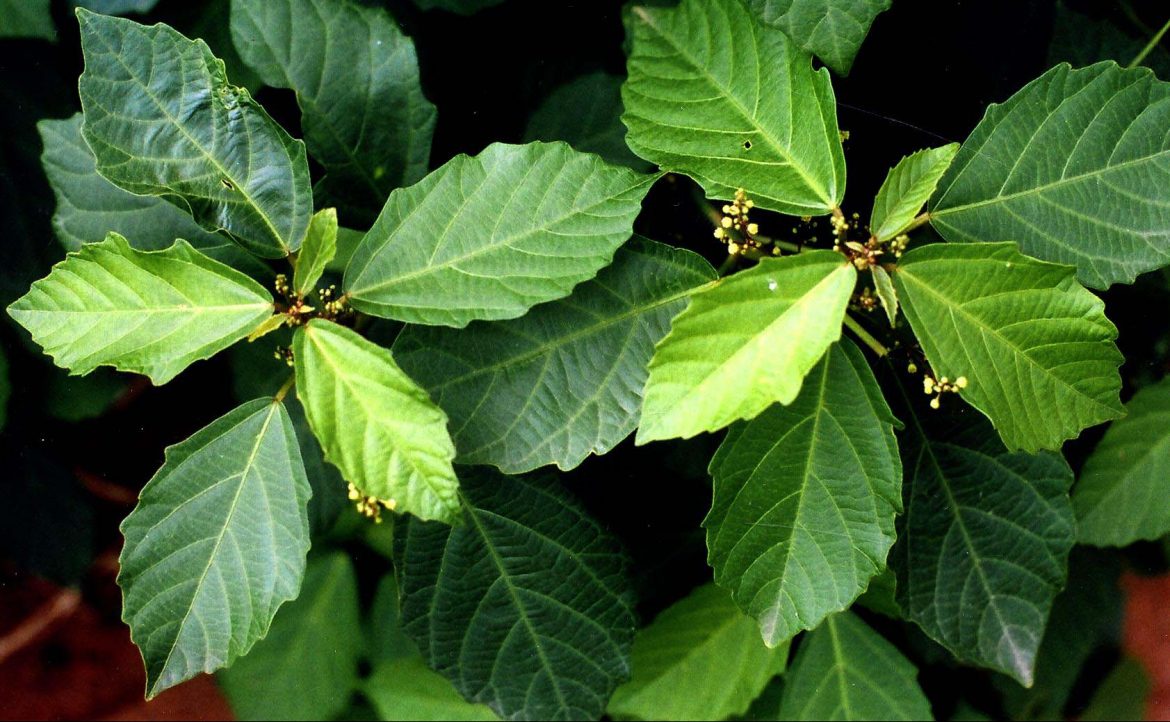
DANTI
- October 26, 2020
- Posted by Dr. Vaidya Karanvir Singh
- 0 Comment(s)
The Danti plant has been considered a medicinal plant in Ayurveda. Detailed mention of the benefits of Danti is found in Charaka Samhita and Sushruta-Samhita. Danti roots are found in the market in the form of pieces of wood. The roots, stem, flowers and fruits of this plant are useful for all health. Danti is very beneficial in treating diseases related to teeth and stomach. In this article, we are telling you about the benefits, medicinal properties and methods of usage of Danti.
Table of Contents
What is Danti?
The plant of Danti is 90–180 cm tall and its branches are white, green in color. Its leaves are 5–8 cm long in round shape. Its flowers grow in bunches which are green and yellow in color. Its fruits are hairy and about one cm long, oval. Flowers grow in it from October to March.
Name of Wild croton in Different Languages
The botanical name of Danti is Baliospermum solanifolium (Burm.) Suresh (Balliospermum solanifolium) Syn-Baliospermum montanum (Willd.) Muell.- Arg., Baliospermum axillare blume. It is a plant of Euphorbiaceae (Euphorbiaceae) clan. Let us know by what names it is called in different languages.
Wild croton in:
English: Wild croton
Sanskrit: Danti, Udumbarparni, Nikumbh, Erandaphala, Jastra, Pratishtrani
Hindi: Danti, Chotidanti, Tamba;
Kannad: Danti, Kaduharalu
Gujrati: Danti, Dantimul, Jamalgota
Tamil: Nakadanti, Niradimuttu
Bengali: Danti, Hakun
Medicinal properties of Danti:
*Danti is bitter, thick, hot, short, sharp, Kaphapittashamak, dipan, purifier, laxative, growth, head, digestive and ulcerative.
*It is inflammation, abdominal disease, worm, haemorrhoids, ashmari, colic, tuberculosis, leprosy, dah, anah, venereal disease, renunciation, rheumatism, tetanus, fever, mania, rashes, spleen disease, disease and pamas.
*Danti oil / seed is hard, bitter, bad, weak, defective, hyperpigmented and vicious.
*It is anah, abdominal disease, rheumatism, venereal disease, rash, fever, mania and catarrh.
*Its origin is thermogenesis, purulent, inflammatory, digestive, vermin, diuretics, blood pressure, febrifuge and force.
*Its seeds are sterile, bloody and stimulating.
Uses and Benefits of Danti
According to Ayurvedic experts, Danti is very useful for problems related to breath and stomach related diseases. Let us know how to use Danti in different diseases.
Danti reduces eye pain
Mixing honey in the juice of Danti root and applying it as kajal in the eyes provides relief from eye pain.
Uses of Danti for Tooth related problems
Make powder by taking equal quantity of root of Danti, Satanashi root, Kasis, Vividing and Indrive. Massage your teeth with this powder. Rubbing this powder on the teeth kills worms and gets rid of tooth decay.
Uses of Danti in Treatment of Respiratory Diseases
If you are troubled by problems in breathing, swelling in lungs, etc. then Danti is a useful medicine for you. Make a decoction of 10-15 ml of Danti leaves and eat it. It provides relief in problems related to breath.
Danti removes the problem of collecting gas in the stomach
Many times the gas starts collecting in the stomach, it feels like a gas ball has formed in the stomach. In Ayurveda, this problem has been named Gulam. Taking 5-10 grams of Danti, Dravanti root paste along with Dadhi, Buttermilk, Alcohol, Mand and Sidhu provides benefits in gum disease and stomach diseases.Taking Danti oil with rock salt and celery provides relief in diseases related to the stomach.
Danti as Laxative helps to clear the stomach
Unclean stomach is the root of many diseases. While many people consider it as a common problem and ignore it. You can use Danti as a laxative (purulent or stomach cleansing medicine). For this, by cooking the sugarcane pieces covered with Danti and Dravanti paste in a Putpak method, then extract the juice and drink it in 10-15 ml quantity. By drinking this, the stomach clears easily.
Benefits of Danti in dysentery
Mixing equal quantity of teeth, chitrak and pippali with water and drinking it with lukewarm water provides quick benefit in dysentery.
Benefits of Danti in the treatment of hemorrhoids
Cook the leaves of Nishoth, Danti, Palash, Changeri and Chitrak in ghee and oil and make a vegetable. Taking it with curd provides relief in piles.
Digestive fire is increased by taking 5-10 ml of dentine, due to which imbalance of defects is corrected. Its regular intake provides benefits in housewives and piles.
Useful Parts of Danti
According to Ayurvedic texts, the following parts of Danti should be used.
The root,seed,Leaves
Where is Danti found or grown?
In India, this plant is found in the Himalayas from Kashmir to Arunachal Pradesh up to an altitude of 600–1000 m. Apart from this, Danti plant is found up to 1800 m height in hill areas of Assam, Deccan Peninsula, Bengal, Bihar, Konkan, Karnataka, Western Ghats and Kerala. It is found in Indo-Malaysia regions, China, Java, Thailand, Myanmar, Malay Peninsula, Bangladesh in the world.

Dr. Vaidya Karanvir Singh is the younger Vaidya in Chandigarh Ayurved & Panchakarma Centre. He is the fourth generation in his family who is practicing as a general consultant in Ayurved & Panchakarma treatment at Chandigarh. In his practice, he had treated more than 1 Lakh Plus patients worldwide.

